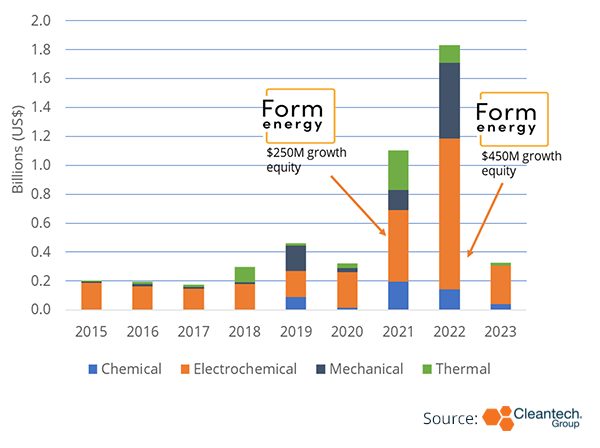Long Duration Energy Storage: Technology Ready, but Where is the Money?
Net-zero targets and uniform efforts to decrease the share of fossil fuels in the global power mix have seen the penetration of renewable power in many countries increase exponentially. Once the wind or solar penetration of a country exceeds 50%, they will need long duration energy storage (LDES) of over 10 hours to act as a backup for renewable generation.
Current incumbent solutions, lithium-ion and pumped storage, have their limitations so there is a need for alternative solutions. Over the last few years over 19 innovators developing LDES have completed their demonstration plants, and many are now working on commercial plants.
While a number of these technologies, such as gravitational and thermal storage, are approaching commercial readiness, questions around customer offtake and business models remain.
Limited Business Models Beyond 10-12 Hours
Battery and storage developers that offer energy storage for up to 12 hours can charge up when power prices are low, using cheap or even to-be-curtailed renewable generation, and discharge when power prices are high, profiting from the fluctuations on the wholesale market.
A prerequisite here, of course, is a liquid and well-functioning power wholesale market. Alternatively, the innovators will have to sign bilateral agreements with utilities or other offtakers. Further, the delta between high and low prices must be big enough to make a material difference.
Some wholesale markets, such as the UK, are believed to be advanced enough that batteries can make enough revenue purely on a merchant basis by taking a view on power prices and selling their production. This works for innovators like Brenmiller Energy, Invinity Energy Systems or Quidnet Energy, who are developing storage solutions for the duration of roughly 12 hours.
Short cycling and fast response time also enable storage solutions to secure ancillary grid contracts for services such as inertia and frequency control and thus maximize revenues for their supply. The caveat is that prices typically decline once battery penetration increases.
Seasonal storage systems that store energy for days and weeks, such as the CAES/hydrogen solution by Corre Energy or the iron-air solution by Form Energy, help combat the dreaded dunkelflaute – long periods where there is no wind or solar. However, these systems are often bulky and do not have the fast response times required to benefit from wholesale arbitrage or a range of ancillary services.
For seasonal storage, capacity payments secured from the transmission system operators (TSO’s) that ensure a steady payment for the system to be on standby, can be the main source of revenue. But these capacity payments are typically not high enough to offset the CAPEX cost of a big grid-scale system.
Energy Storage: Venture and Growth Capital Investments, 2015-2023

i3 database, *Electrochemical investments exclude lithium-ion chemistries
Utilities on the Fence
Then there’s a lag from customer uptake. The innovators say that the interest from utilities is high, but this does not translate into contracts signed nor money invested. Based on the investments into LDES, interest from utilities is lukewarm. ENI and National Grid have both invested in Form Energy, an iron-air battery producer whose technology is poised to be the workhorse of the grid, providing cheap storage for hundreds of hours. Not a single utility is a member of the Long Duration Energy Council, the umbrella organization for storage developers.
In the renewable industry, contractually binding power purchase agreements (PPAs) are a standard that gives the developers the certainty of the offtake and makes projects bankable for financiers. So far, only a handful of PPA’s have been signed, like the one by adiabatic compressed air (a-CAES) developer Hydrostor’s 25-year year PPA with Central Coast Community Energy.
Gravity-based storage operator Energy Vault signed a 10-year tolling agreement with PG&E, while mechanical pumped storage developer Quidnet secured a 15-year commercial offtake agreement with CPS Energy.
Typically, innovators carry most of the technology development risk under the signed contracts. For customers it makes sense to wait to see which technologies and innovators come out from the scaling challenge successfully. Utilities do not have the reputation for being the first adopters of new technology. Some, like EDF and Enel, are partnering with innovators, however, to expand their demonstration projects.
Governments to the Rescue
Oil and gas companies, such as Shell, Chevron and Equinor, have had some involvement through their venture capital arms. Equally, oil field services companies, like Schlumberger and Nabors have invested $170M in storage technologies.
Meanwhile, national governments have stepped up with unprecedented support. The U.S. Department of Energy, the Australian Renewable Energy Agency (ARENA) and the UK’s Department for Business, Energy and Industrial Strategy (BEIS) have invested close to $800M in different emerging LDES technologies. Most recently (in April), the newly formed UK Department for Energy Security and Net Zero (DESNZ) allocated $37.5M in grants to Cheesecake Energy, Invinity, and Synchrostor.
Zainab Gilani, Research Analyst at Cleantech group, talks about how the need for long-duration energy storage (LDES) for flexibility and grid stability is rapidly increasing. Cleantech Group is exploring some of the most interesting innovation in this field. Zainab will share the key trends and challenges in this sector.



